The Post War Mini-Car Boom
In
1951 the by then well established agricultural machinery firm of Hans Glas GmbH of Dingolfing, Germany, decided to move into the motoring field, firstly with a scooter and then with a proper car. The post-war crisis in Germany had led to a boom in mini-cars and three-wheelers, with such machines as the Heinkel, Isetta and Messerschmitt gaining a good share of the market, especially in export markets such as the UK where three-wheelers offered special advantages in low taxation and their availability to the holders of motor-cycle licences who wanted more comfort than two wheels could afford.
The Goggomobil
Glas decided to ignore the three-wheeler market and go for a really small car, the Goggomobil, which first appeared in
1955. This tiny two-door saloon was only 9 feet 6 inches long and featured swing-axle suspension front and rear, tiny 10 inch wheels, rack-and-pinion
steering and drum
brakes on all wheels. The engine was mounted at the rear of the car, the first unit offered being a twin-cylinder, two-stroke engine mounted transversely in the car.
This was basically a motor-cycle engine which gave 13.6 bhp at 5400 rpm from its 247 cc, endowing the 8 cwt car with a top speed of 49 mph and a fuel consumption of more than 50 mpg. The four-speed transmission was a motor-cycle non-synchromesh gearbox in unit with a multi-plate wet clutch, an unusual feature being that the floor-mounted
gear lever had to be operated by moving it across the car from side to side.
The Glas T250 and T400
The Glas T250, as it was called, soon became popular with drivers who required a very basic economy car. Later, the engine was made available as a 296cc unit, which gave 15 bhp at 5000rpm and raised the top speed to 52mph, while an even bigger version with a 395 cc capacity gave 18.5 bhp at 5000 rpm. This model, the T400, eventually became the most popular as it was capable of exceeding 60mph yet still gave a very respectable fuel consumption of around 50mpg.
Glas soon realised the possibilities of their little car and decided to bring out a coupe version. This pretty little machine with a body reminiscent of the Alfa Romeo Giulietta coupe was a great success with enthusiasts and, although it was available with the 250, 300 and 400 cc engines, it was seldom bought in anything but the 400cc form. Mechanically, it was virtually the same as the saloon model but its superior
aerodynamic shape gave it a top speed of around 65 mph.
The Glas Isar T600 and T700
A delightful optional extra on the coupe was the French Cotal electric gearbox which gave fingertip gearchanging. Several examples of the T400 coupe were raced with a moderate amount of success, notching up several class wins, mainly because of the negligible opposition. With increasing prosperity, the demand for bigger cars grew, so in 1958 Glas introduced the new Isar T600 and T700 sedans, followed by a wagon version. These models were conventional front-engined cars with rather ugly two-door bodies. Front suspension was by an unusual combination of trailing upper wishbones and transverse lower arms in conjunction with coil springs and telescopic dampers, while the live rear axle was mounted on semi-elliptic leaf springs.
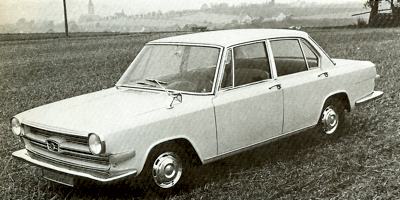 1963 Glas 1500cc sedan.
1963 Glas 1500cc sedan.
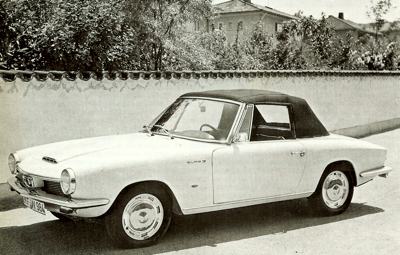 Sister car to the Frua coupe was the Glas S1300GT.
Sister car to the Frua coupe was the Glas S1300GT.
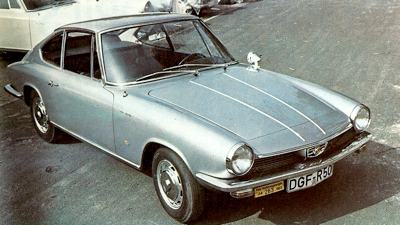 1964 Glas S1300GT, with coachwork by Pietro Frua.
1964 Glas S1300GT, with coachwork by Pietro Frua.
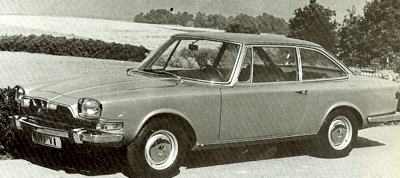 Glas became contemporary in 1965 when it introduced the new V8 series.
Glas became contemporary in 1965 when it introduced the new V8 series.
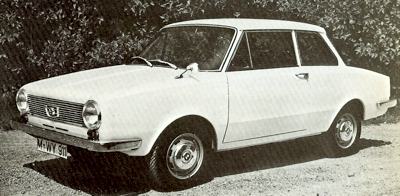 1968 Glas 1304CL, which was powered by a 1289cc engine.
1968 Glas 1304CL, which was powered by a 1289cc engine. |
Steering was cam-and-peg, drum
brakes being fitted on all four wheels. Power came from a flat-twin, four-stroke engine which gave 19 bhp at 4800 rpm in 548 cc form and 30 bhp at 4900 rpm in 688 cc form. Although the T700 was capable of 70 mph, against the 60 mph of the T600, neither model really caught on and, even though they were still catalogued in 1964, production had slowed down to a dribble. In 1961, Glas showed that they had ambitions of invading the car market in a big way by introducing a range of technically advanced cars.
The Italian stylist Pietro Frua had been engaged to carry out body design, and he produced a handsome range of sedans, coupes and convertibles. The first models to emerge were the S1004 coupe and convertible, which had a chassis layout similar to that of the Isar except that the wheelbase was lengthened by 5 inches. The most interesting part of the car was the engine, an entirely new, four-cylinder, water-cooled single-overhead-camshaft unit. The camshaft operated inclined valves in a hemispherical combustion chamber and the camshaft was driven by an internally toothed cogged belt.
This was one of the first applications of the exposed cogged-belt drive, and Glas found that it worked satisfactorily. With a cast-iron block, light alloy head and five main bearings, the engine proved to be a rugged unit, giving 42 bhp at 5000 rpm from its 992 cc. A four-speed, all-synchromesh gearbox was fitted and top speed for the coupe was about 85 mph. Mechanically, the convertible was identical to the coupe. The cars were also made available as the S1204 with an 1189 cc version of the engine, which gave 53 bhp at 5100 rpm and increased the top speed up to a very healthy and useful 90 mph.
The Glas S1300GT
By 1964, entirely new coupe and convertible models were available, with stylish bodies by Frua. These were known as the S1300GT and were complementary to the S1004 which, the company decided, should stay in production. The cars featured an improved chassis, with the wheelbase lengthened to 8 feet 7 inches and conventional double-wishbone front suspension. Disc
brakes were already standard on the front wheels and the cogged-belt engine was increased in size to 1289cc with the power up to 75 bhp at 5800 rpm, giving both models a top speed of 105 mph. Also available in 1964 was the 1500, a four door saloon with similar suspension to the 1300GT models but with its wheelbase increased to 9 feet 2
½ inches and the familiar engine increased in size to 1492cc, although the power was kept down to 70 bhp in the interests of improved torque for improved mid-range acceleration.
The seeds of financial trouble to come were sown at this time, for Glas seemed reluctant to drop any model, however unsuccessful, and the range still contained the Goggomobil and Isar models as well as the variations on the S1004, 1300 and 1500. Demand for the smaller models had long evaporated in the face of the challenge from Volkswagen and the many other small-car producers, yet they stayed in production. By 1965 there were both sedan and wagon variants of the 1004 in the catalogue, both of which were available with the 1289cc engines as options, while the 1500 had grown into the 1700, the cogged-belt engine now stretched to 1682cc and the power output raised to 85 bhp at 4800 rpm.
Glas claimed a top speed of 100 mph for the 1700, although a UK magazine only managed to squeeze 90 mph out of a test example. A TS version with an engine tuned to give 100 bhp at 5500 rpm was also catalogued. This engine was also made available for the 1300 GT coupe and convertible, which were known as the 1700 GTs. The 1700 was capable of 115 mph according to Glas, but the 1300 versions remained in production for those with less sporting inclinations. Not content with this unwieldy range, Glas introduced a big sedan in 1965, a luxury machine powered by a new V8 engine which was, in effect, two of the four-cylinder engines on a common crankcase, with two separate cogged belts driving the single camshafts on each bank.
The Glas 2600 V8
With a capacity of 2576cc this unit represented two of the 1289cc, four-cylinder units and, using three downdraught Solex carburettors conveniently situated in the vee of the engine, it gave 150 bhp at 4600 rpm. Although it featured the same wheelbase as the 1700 saloon, the 2600 V8 used a de Dion rear axle in conjunction with semi-elliptic leaf springs. Automatic chassis levelling control by Boge was fitted as standard equipment. Glas claimed a top speed of 124 mph for the 2600 but the expense of putting the car into production took the company into serious financial trouble by early 1966.
The Glas factory and its assets were taken over by BMW, who themselves had weathered a severe financial storm only four or five years earlier. BMW immediately dropped all the smaller models which were uneconomical and kept only the 1700GT and 2600 V8 in production. They fitted their own 1600 cc, four-cylinder engine into the 1700GT and also grafted their trailing-arm independent rear suspension onto some models. The 1700GT was renamed the 1600GT but it lasted in production only a short while and, by 1969, the name of Glas had been erased from the BMW catalogues.
Also see: Glas Car Reviews



